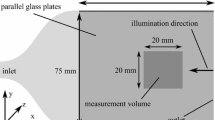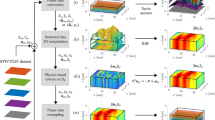Abstract
In order to accurately assess measurement resolution and measurement uncertainty in DPIV and TPIV measurements, a series of simulations were conducted based on the flow field from a homogeneous isotropic turbulence data set (Re λ = 141). The effect of noise and spatial resolution was quantified by examining the local and global errors in the velocity, vorticity and dissipation fields in addition to other properties of interest such as the flow divergence, topological invariants and energy spectra. In order to accurately capture the instantaneous gradient fields and calculate sensitive quantities such as the dissipation rate, a minimum resolution of x/η = 3 is required, with smoothing recommended for the TPIV results to control the inherently higher noise levels. Comparing these results with experimental data showed that while the attenuation of velocity and gradient quantities was predicted well, higher noise levels in the experimental data led increased divergence.




















Similar content being viewed by others
References
Antonia RA, Mi J (1993) Corrections for velocity and temperature derivatives in turbulent flows. Exp Fluids 14:203–208. doi:10.1007/BF00189511
Atkinson C, Soria J (2009) An efficient simultaneous reconstruction technique for tomographic particle image velocimetry. Exp Fluids, p 116
Cadot O, Douady S, Couder Y (1995) Characterization of the low-pressure filaments in a three-dimensional turbulent shear flow. Phys Fluids 7:630–646
Chong MS, Perry AE, Cantwell BJ (1990) A general classification of three-dimensional flow fields. Phys Fluids 2:765–777
Davidson P (2004) Turbulence, an introduction for scientists and engineers. Oxford University Press, Oxford
Douady S, Couder Y, Brachet ME (1991) Direct observation of the intermittency of intense vorticity filaments in turbulence. Phys Rev Lett 67:983–986
Elsinga G, Scarano F, Wieneke B, van Oudheusden B (2006) Tomographic particle image velocimetry. Exp Fluids 41:933–947
Foucaut JM, Carlier J, Stanislas M (2004) PIV optimization for the study of turbulent flow using spectral analysis. Meas Sci Technol 15:1046–1058. doi:10.1088/0957-0233/15/6/003
Ganapathisubramani B, Lakshminarasimhan K, Clemens NT (2007) Determination of complete velocity gradient tensor by using cinematographic stereoscopic PIV in a turbulent jet. Exp Fluids 42:923–939. doi:10.1007/s00348-007-0303-5
Herman G, Lent A (1976) Iterative reconstruction algorithms. Comput Biol Med 6:273–294
Hinsch K (2002) Holographic particle image velocimetry. Meas Sci Technol 13:R61–R72
Hori T, Sakakibara J (2004) High-speed scanning stereoscopic PIV for 3D vorticity measurement in liquids. Meas Sci Technol 15:1067–1078
Hwang W, Eaton JK (2004) Creating homogeneous and isotropic turbulence without a mean flow. Exp Fluids 36:444–454. doi:10.1007/s00348-003-0742-6
Ishihara T, Gotoh T, Kaneda Y (2009) Study of high-reynolds number isotropic turbulence by direct numerical simulation. Annual Annu Rev Fluid Mech 41:165–180. doi:10.1146/annurev.fluid.010908.165203
Lavoie P, Avallone G, de Gregorio F, Romano GP, Antonia RA (2007) Spatial resolution of PIV for the measurement of turbulence. Exp Fluids 43:39–51. doi:10.1007/s00348-007-0319-x
Lecordier B, Demare D, Vervisch LMJ, Réveillon J, Trinité M (2001) Estimation of the accuracy of PIV treatments for turbulent flow studies by direct numerical simulation of multi-phase flow. Meas Sci Technol 12:1382–1391. doi:10.1088/0957-0233/12/9/302
Liu S, Katz J, Meneveau C (1999) Evolution and modelling of subgrid scales during rapid straining of turbulence. J Fluid Mech 387:281–320
Maas H, Gruen A, Papantoniou D (2004) Particle tracking velocimetry in three-dimensional flows. Exp Fluids 15:133–146
Mullin JA, Dahm WJA (2006) Dual-plane stereo particle image velocimetry measurements of velocity gradient tensor fields in turbulent shear flow. II. Experimental results. Phys Fluids 18(3):035102. doi:10.1063/1.2166448
Nobach H, Bodenschatz E (2009) Limitations of accuracy in PIV due to individual variations of particle image intensities. Exp Fluids 47:27–38. doi:10.1007/s00348-009-0627-4
O’Neill P, Soria J (2005) The relationship between the topological structures in turbulent flow and the distribution of a passive scalar with an imposed mean gradient. Fluid Dynam Res 36:107–120
Ooi A, Martin J, Soria J, Chong MS (1999) A study of the evolution and characteristics of the invariants of the velocity-gradient tensor in isotropic turbulence. J Fluid Mech 381:141–174
Pao YH (1965) Structure of turbulent velocity and scalar fields at large wavenumbers. Phys Fluids 8:1063–1075. doi:10.1063/1.1761356
Raffel M, Willert C, Kompenhans J (1998) Particle image velocimetry: a practical guide. Springer, New York
Schröder A, Geisler R, Elsinga G, Scarano F, Dierksheide U (2006) Investigation of a turbulent spot using time-resolved tomographic PIV. In: 13th international symposium on applications of laser techniques to fluid mechanics, Lisbon, Portugal
Soloff SM, Adrian RJ, Liu ZC (1997) Distortion compensation for generalized stereoscopic particle image velocimetry. Meas Sci Technol 8:1441–1454. doi:10.1088/0957-0233/8/12/008
Sreenivasan KR (1998) An update on the energy dissipation rate in isotropic turbulence. Phys Fluids 10:528–529. doi:10.1063/1.869575
Tanahashi M, Miyauchi T, Ikeda J (1999) Fine scale structure in turbulence, fluid mechanics and its application. In: IUTAM Symposium on simulation and identification of organized structures in flows, fluid mechanics and its applications, vol 52. pp 131–140
Tsinober A, Kit E, Dracos T (1992) Experimental investigation of the field of velocity gradients in turbulent flows. J Fluid Mech 242:169–192. doi:10.1017/S0022112092002325
Westerweel J (1994) Efficient detection of spurious vectors in particle image velocimetry data. Exp Fluids 16:236–247. doi:10.1007/BF00206543
Wieneke B (2005) Stereo-PIV using self-calibration on particle images. Exp Fluids 39:267–280. doi:10.1007/s00348-005-0962-z
Wieneke B (2007) Volume self-calibration for stereo-PIV and tomographic-PIV. In: 7th international symposium on particle image velocimetry, Rome, Italy
Wieneke B, Taylor S (2006) Fat-sheet PIV with computation of full 3D-strain tensor using tomographic reconstruction. In: 13th international symposium on applications of laser techniques to fluid mechanics, Lisbon, Portugal
Willert CE, Gharib M (1992) Three-dimensional particle imaging with a single camera. Exp Fluids 12:353–358
Worth N, Nickels T (2007) A computational study of tomographic reconstruction accuracy and the effects of particle blocking. In: 5th Joint ASME/JSME Fluids Engineering Conference, San Diego, California
Worth NA, Nickels TB (2008) Acceleration of Tomo-PIV by estimating the initial volume intensity distribution. Exp Fluids 45:847–856. doi:10.1007/s00348-008-0504-6
Wyngaard JC (1968) Measurement of small-scale turbulence structure with hot wires. J Phys E Sci Instr 1:1105–1108. doi:10.1088/0022-3735/1/11/310
Zhang J, Tao B, Katz J (1997) Turbulent flow measurement in a square duct with hybrid holographic PIV. Exp Fluids 23:373–381
Zhu Y, Antonia RA (1996) The spatial resolution of hot-wire arrays for the measurement of small-scale turbulence. Meas Sci Technol 7:1349–1359. doi:10.1088/0957-0233/7/10/006
Zocchi G, Tabeling P, Maurer J, Willaime H (1994) Measurement of the scaling of the dissipation at high Reynolds numbers. Phys Rev E 50:3693–3700. doi:10.1103/PhysRevE.50.3693
Acknowledgments
Dr. Tanahashi of Tokyo Tech is acknowledged for the DNS data. The first author wishes to acknowledge funding from the Engineering and Physical Sciences Research Council, through a Cambridge University Doctoral Training Award.
Author information
Authors and Affiliations
Corresponding author
Rights and permissions
About this article
Cite this article
Worth, N.A., Nickels, T.B. & Swaminathan, N. A tomographic PIV resolution study based on homogeneous isotropic turbulence DNS data. Exp Fluids 49, 637–656 (2010). https://doi.org/10.1007/s00348-010-0840-1
Received:
Revised:
Accepted:
Published:
Issue Date:
DOI: https://doi.org/10.1007/s00348-010-0840-1




